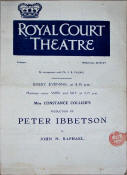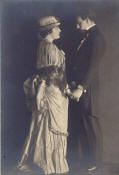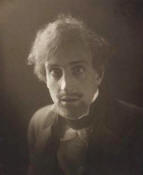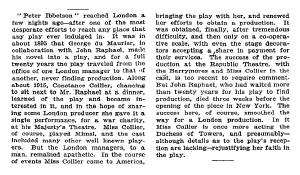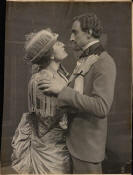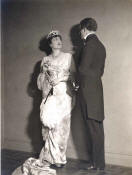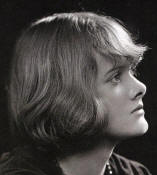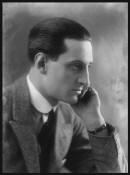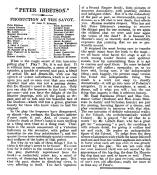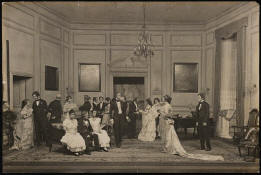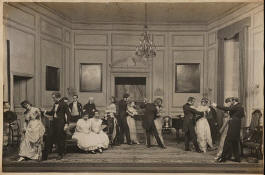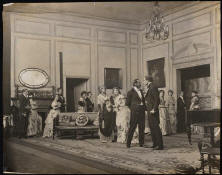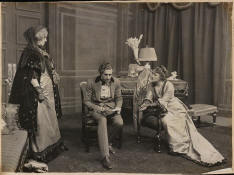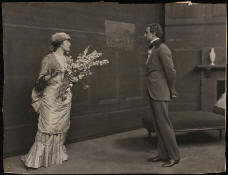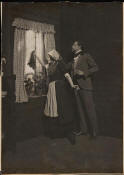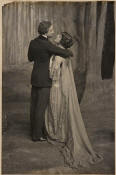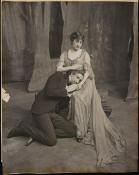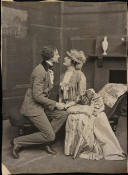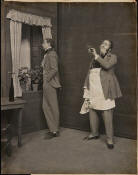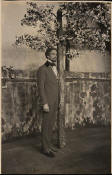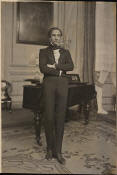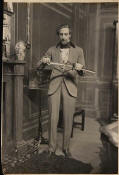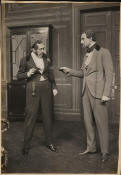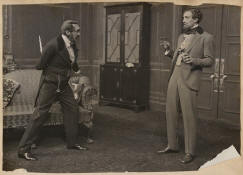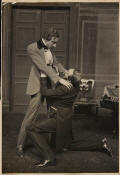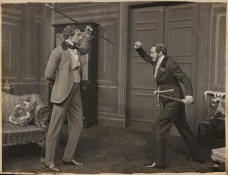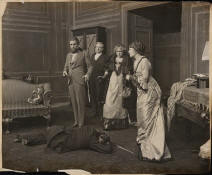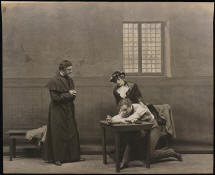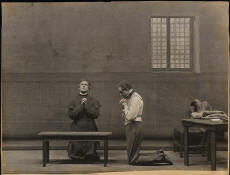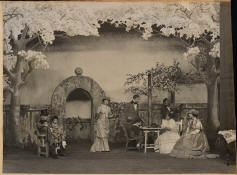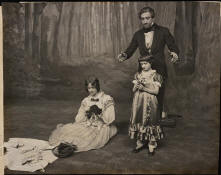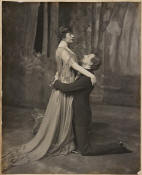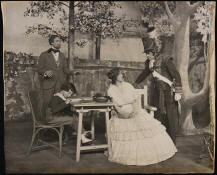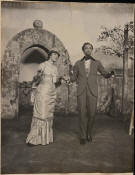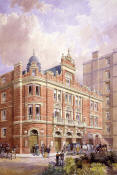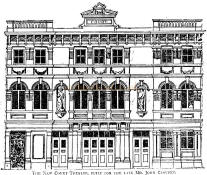Peter IbbetsonA play in four acts by John N. Raphael (based on the novel by George du Maurier). Opened at the Savoy Theatre, London, February 4, 1920, and ran through April 3. The play then transferred to the Royal Court Theatre in Sloane Square, where it ran from April 26 to May 29, 1920 (106 performances total). Produced by Constance Collier by arrangement with J.B. Fagan. Stage manager, J. Wallett Waller; Assistant Stage Manager, Frank M. Quinn; Acting Manager, William J. Rice; General Director, William Burchill.
In this beautiful love story, Peter Ibbetson dreams of his childhood and of his happy days with a little girl named Mimsey. He had been raised in Paris until his parents died, and his English uncle brought him back to England. Growing up with his cruel uncle as guardian was hard. Peter becomes a lonely, hard-working architect. He meets and falls in love at first sight with Mary, the Duchess of Towers. Peter discovers that the Duchess is in fact his childhood friend Mimsey, now grown up. After that meeting, they are parted forever in real life, but they dream the same dream, and thus share a life together in their dream world. One evening Peter quarrels with his
uncle regarding lies his uncle told about Peter's mother. In justified rage,
Peter
kills him. On the night that he is
sentenced to be hanged, Mary comes into his dream again and tells him
that the sentence will be commuted, and that after she is separated from
her wretched husband she will make his life happy. Then comes an ideal
dream-life of twenty-five years, that must be read to be understood and
appreciated, during which Mary’s outward life is spent in philanthropy
and Peter’s is spent in jail. When she dies, and their mutual dream-life
ends, Peter becomes wildly insane. She visits him once after her death,
and gives him strength to recover and write this singular autobiography.
Based on George du Maurier's 1891 novel, John Raphael's play Peter Ibbetson was written in 1899. Raphael was unable to find someone to produce the play until he met Constance Collier. After a single performance in London in 1915, Collier brought the play to the USA and produced it on Broadway in 1917. John Barrymore played the title role of Peter Ibbetson. After a season in New York and a full year on the road, Constance Collier returned to England, determined to produce Peter Ibbetson on the London stage. Seeking a leading man who could equal John Barrymore's interpretation, Collier interviewed Henry Daniell, George Relph, and Basil Rathbone. In his autobiography, Rathbone wrote that after interviewing with Constance Collier, he felt confident that he would get the part. The following day he was enjoying a drink in a London pub when Henry Daniell walked in. Basil was dismayed to discover that Henry was up for the same part! And then George Relph joined them and they learned that he, too, had auditioned for the role of Peter Ibbetson! Each of them felt that the interview with Miss Collier had gone well, and that he had been awarded the role. George Relph then pointed out that the actor who had quoted the lowest salary to Miss Collier no doubt got the job. Relph had quoted twenty-five pounds per week, Daniell twenty pounds, and Rathbone ten pounds. And Basil had indeed gotten the part! Unfamiliar to the critical audiences of London, 27-year-old Basil Rathbone was an overnight hit. "That first night," he exclaimed, "will never leave me. All the fine men of the theatre, the actors whom I'd worshipped from a distance, were there. And they walked up on the stage to congratulate me! Forbes Robertson, whose 'Hamlet' I'd seen four times. Sir John Hare and all the rest!" ("Buoyant Battler," Modern Screen, December 1937)
In an interview for Screen Book magazine Rathbone said, "Our present life is extremely practical and we need, as much as possible, to create moods of illusion—we must not forget how to dream. My first successful play and possibly, my dearest memory of the stage, was Peter Ibbetson. In it, my beloved one, Mary, Duchess of Towers, taught me how to dream true, and the tragic life of Peter was changed into exalted happiness. Though he passed the last twenty years of his life in prison, he had his dreams which were reality to him, and he knew—'that stone walls do not a prison make, nor iron bars a cage!'" ("Peer of the Costume Drama," Screen Book, May 1938)
"The revival of Peter Ibbetson at the Savoy was a big success. Storms of applause greeted each curtain." —Variety, February 13, 1920 "The first four performances of Peter Ibbetson at the Savoy broke the records of that house for the last ten years." —Variety, February 20, 1920
When Daphne du Maurier saw Basil Rathbone in her grandfather's play, she was smitten with the handsome young actor. She later wrote: "Upon an earlier piece of pink blotting paper there is the drawing of a heart, pierced by an arrow, and the words, 'I love Basil,' scribbled upon it. This, I know very well, refers to the actor Basil Rathbone, who had performed as the hero in the adaptation of Grandpapa's novel Peter Ibbetson, staged some months before. It was time, I must have told myself, that I too found an idol or 'crush,' ... and Basil Rathbone, dark and handsome, made a fine candidate, especially when he helped us at the hoopla stall, over which M presided at the annual Theatrical Garden Party. Passion withered when he appeared—I think at a garden party D and M gave at Cannon Hall—wearing a straw boater, and though I tried hard to flog the dying embers ... I didn't succeed. I wondered what I should have said had I known that over twenty years later he would act the part of wicked Lord Rockingham in the film adaptation of one of my own novels, Frenchman's Creek, and in pursuit of the heroine, Dona, crash down a staircase to his death?" —Daphne du Maurier, Myself When Young: The Shaping of a Writer (New York: Doubleday & Co., 1977)
In 1940, Rathbone recalled Daphne's admiration. “Daphne du Maurier ... flattered my vanity when she was a young girl of 14. I was appearing with her father, Gerald du Maurier, in her grandfather’s play, ‘Peter Ibbetson.’ She adored everything her grandfather had written and I was for the run of the play, at least, her hero. She was a lovely young girl and I was just at the age when a bit of worship did me a lot of good.” —“Handsome Villain,” The Milwaukee Journal, June 2, 1940
"Mr. Gilbert Hare makes a superbly vain uncle, and Mr. Basil Rathbone a Peter full of charm and interest." —The Sphere, March 13, 1920 "In Basil Rathbone the English stage has found an emotional actor of the first class, a young man whose power of expressing sorrow, at all events, is so great that in one night he climbs to the very topmost pinnacle, among the few really gifted actors of his time." —National News, February 1920
In 1921 a silent film version of Peter Ibbetson was directed by American George Fitzmaurice. Titled Forever, it was written by scenarist Ouida Bergere, who was then married to Fitzmaurice. In 1926 she became the wife of Basil Rathbone. In his autobiography, Basil Rathbone wrote: "The success of Peter Ibbetson was also linked with the years to come. The authoress of the silent picture version of the story was one day to become my wife. But at this moment neither of us had heard of one another." (In and Out of Character, p. 45)
Peter Ibbetson opened at the Savoy Theatre on February 6, 1920, and played six nights and two matinees each week until April 3. On April 26 the play transferred to the Royal Court Theatre in Sloan Square.
|
|||||||||||||||||||||||||||||||||||||||||||||||||||||||||||||||||||||||||||||||||||||||||||||||







